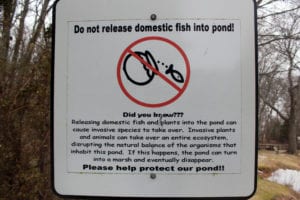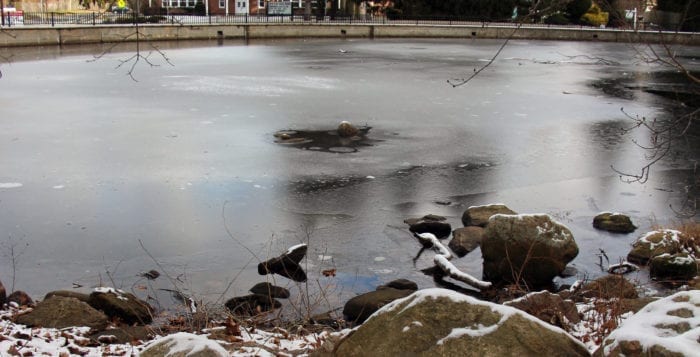Miller Place Duck Pond looking for a little help
Town of Brookhaven submits grant application to pay for dredging
A local ecosystem needs saving.
The Miller Place Duck Pond — located at the intersection of North Country Road and Rocky Point Landing Road — is too low, looks dirty in the summertime and appears to be invaded by destructive species.
Those are some of the complaints residents have made to Tom Carrano, Brookhaven’s assistant waterways management supervisor, who, along with his team, has been monitoring the pond in recent years, determining that the concerns are valid.
The small but vibrant pool of water, which sits across from Laddie A. Decker Sound Beach School and has long served as an educational tool for its teachers, has been found to be overrun with a multitude of plant species not native to Long Island, some identified and some not, which Carrano said have the potential to “wreak real havoc.”
“There aren’t that many areas left where local amphibians and reptiles can go on the North Shore, so these small systems are extremely important.”
— Tom Carrano
The pond currently contains water lilies, plants that thrive in areas of high nitrogen loading and sedimentation, and, possibly, Caboma and watermilfoils — plants whose root systems are known to threaten the quality of fresh waters, greatly affecting swimming and fishing.
Because of these findings, the town board recently submitted a grant application to the Suffolk County Water Quality Protection and Restoration Program as well as the Stewardship Initiative in hopes of acquiring funds to eradicate the invasive species and restore and maintain the health of the water.
“We’re just hoping to make this little ecosystem — which is very special to the community — better than it is today,” Carrano said. “There aren’t that many areas left where local amphibians and reptiles can go on the North Shore, so these small systems are extremely important.”
The restoration, of which the projected cost is $240,000 with a $120,000 town match, will include dredging the pond to remove excess sediments and all invasive plant matter and using the highway department’s Vortechs unit — a hydrodynamic separator that “combines swirl concentration and flow controls into a shallow treatment unit and retains trash, debris, sediment and hydrocarbons” — to reduce stormwater runoff and filter clean water from natural wetlands. If the grant is received, Carrano said he expects work would begin in the summer of 2019.
“We have a very comprehensive plan that we’ve worked on and we’d like to go after some grant funding to go and take care of it,” Councilwoman Jane Bonner (C-Rocky Point) said. “We’re taking it piece by piece. We know we can do the dredging in-house, because we’ve done so in the past.”
Bonner said the pond was dredged and invasive species were taken out in the 1980s, but said the problem is, over time, people dump their own fish into the water.

“[Dumping] what’s in their own fish tanks, such as plants, and they’re not native to the Island,” she said. “Birds drop seeds, animals drop seeds and then you have invasives. The grant funds will go toward bringing the pond back to where it was.”
Carrano said by installing the Vortechs unit and creating a cleaner water filter, he is confident it would stop all sediments from entering the water again, eliminating the need to have to worry about dredging the pond for a “very long time after this.”
Although the wetland is outside of his district, state Assemblyman Steve Englebright (D-Setauket) spoke highly of the plan to save it, calling the pond “a crown jewel” in the Miller Place community.
“This is a very important water body simply because it anchors one end of the historic district in Miller Place and is, visually, critically important to the sense of place for that whole area,” the assemblyman said, noting insects reproduce in the water, and it attracts birds, reptiles and local wildlife. “We don’t have many ponds on Long Island on an overall landscape basis and open freshwater bodies are extremely rare, so I would strongly support the idea of restoring it.”
He did, however, warn dredging too deep with a perched pond like this runs the risk of taking away the clay base that holds the water.
“That would not be good,” Englebright said. “So, while dredging makes sense, it also makes sense to try to restore the pond a shallow depth rather than gauging down deeper, which could be dangerous.”







